|
|
|
|
|
|
|
|
|
|
|
|
|
|
|
|
2 sabers on the extreme right -- The top weapon is the personal goosequill saber (yanmaodao) of Nurhachi (lived 1559-1626, late Ming period), the founding father and leader/uniter of the Manchu tribes. His successors went on to complete the conquest of China under the Qing Dynasty. Owned by the Chinese Government, notice the presence of a back-edge towards the tip and the use of red lacquer decorative coating on one of the fullers. The bottom saber, on the other hand, personifies a typical willow leaf saber (liuyedao) of the mid Qing Dynasty, belonging to an Imperial Court official. Check out the "tunkou" or metal collar at the blade forte, a design influence most likely derived from Central Asian Turkic sabers of the 7th~13th centuries AD. It is different in shape compared to the indigenous "tunkou" of Chinese daos of the Tang Dynasty . The distinction between a goosequill saber and a willow leaf saber: The goosequill saber is straight throughout its length until the curve begins around the centre of percussion.The center of percussion is the point on the blade with the least vibration on hard contact, the spot on the blade that transmits the most power to the target in a hard chop. The willow leaf saber, however, has a gentle curve throughout its length, with the steepness of the curve increasing as it moves towards the tip. To view another saber from the late Ming period, and for the comparative blade profiles of a number of goosequill sabers, click on the pic. __________________________________
I would like to acknowledge and credit Mr Philip Tom as the researcher / scholar who has kindly supplied all the following information listed below; he was the one who virtually pioneered the study and classification of the different types of Chinese sabers and their inter-cultural links to other countries.
Relationships between Chinese sabers and sabers of Central Asia and the Islamic World: Even after the Yuan Dynasty, where the Turko-Mongol saber was to become the direct ancestor of the willow leaf and goosequill sabers, Chinese sabers of the Ming and Qing continue to influence and be influenced by the sabers of Central Asia and the Islamic World (including Ottoman Turkey, Persia/Iran, and India).
Chinese and Islamic sabers, owing to both having a common ancestor (the Turko-Mongol saber), and also due to mutual cross-pollination and interaction, have several common features which include:
1) Downward-curving grips (on certain examples)
2) The similar shape of the "tunkou" or collar at the blade forte
3) Similar nuances in blade shapes, fuller designs / arrangements, cutting edge curvature and distal taper
4) Sabers having flat fortes with fullering that begins several inches ahead of the guard (see pic of Nurhachi's saber)
5) The presence of a back-edge at the blade-tip (as can be seen on some of the sabers presented on this webpage); in some examples, this back-edge has a raised profile
__________________________________
Some aesthetic features transmitted from the Islamic World to China would include:
1) Blades with built-in chambers where metal balls -- "rolling pearls" or "tears of the afflicted" would roll
2) Segmented fullers and " U " shaped fuller at the forte
3) "Boxed" fullers where a single fuller is surrounded / enclosed within a "rectangular box"-shaped fuller
4) Chiselled cartouches with calligraphy or patterns of animals (lions, dragons etc) on the blades
5) Dimples or engraved hollow dots at the ends of the fullers (also seen on the sabers of Ottoman Turkey and Mamluk Egypt)
6) The decorative use of Indian diaper patterns consisting of Indian-style koftgari gold inlay, on the fittings of high-end Qing Dynasty Imperial sabers
7) Qing Emperor Qianlong's use of "pistol grip"-shaped saber handles made of jade, following the manner of sabers in contemporary Mughal India (see my webpage on "Qianlong sword named Kouming")
__________________________________
Some aesthetic features transmitted from China to the Islamic World would include:
1) Dragon/phoenix motifs at the fortes of medieval Persian double-edged sword blades
2) Dragon/phoenix/qilin motifs, plus patterns of clouds and lotus flowers, on Ottoman Turkish saber fittings, during the reign of Sultan Suleiman, the Magnificent (who lived from 1495-1566)
__________________________________
The large-scale exports of Japanese swords to China in the early part of the Ming and the serious Japanese piracy threat during the mid-1500s also influenced and stimulated the manufacture and use of one-handed and two-handed Chinese sabers, with 2 specific characteristics:
1) Ridged cross-sections known to the Japanese as "shinogi zukuri" (an originally indigenous Chinese development, previously used in the swords of the Sui and Tang Dynasties)
2) A specific type of blade curvature similar to those of Japanese swords, known as "koshizori" (steeper arc or curve towards the guard, straightening out towards the tip), which was different from the curvatures of the typical willow leaf and goosequill sabers
In the mid-Qing, there appears to be several Imperial sabers, commissioned by Emperor Qianlong and by other high-ranking officials, and made by the Imperial Workshops, which have a ridged cross-section and 2 fullers, one long and one short, on both sides of the blade. It was most likely, modelled after one type of Japanese sword known as "naginata naoshi katana", which in turn was modelled after the Japanese naginata polearm.
Extant examples of such Chinese blades with Japanese influence can still be seen in some private and public collections. See the "Miao Dao" below.
__________________________________
Other cross-cultural influences include the transmission to China of pattern-welded twistcore swordmaking techniques, probably from Indonesia and/or the Southern Philippines (credit to Philip Tom's hypothesis), in the early Ming. Refer to the saber in the collection of the Metropolitan Museum of Art on this webpage. Chinese swordmaking techniques were also passed on to Vietnam, Laos and Thailand during the Ming and Qing Dynasties. Another recipient was Korea, which had absorbed Chinese swordmaking influences from the Han Dynasty right down to the Qing.
__________________________________
Full acknowledgement, credit and thanks to Mr Philip Tom for his meticulous research on these relationships. __________________________________
For close-up pics of 15 antique daos and jians (dating from Qing Dynasty onwards) which had been repolished / restored, go to my webpage: www.chinahistoryforum.com/chinesesword/
|
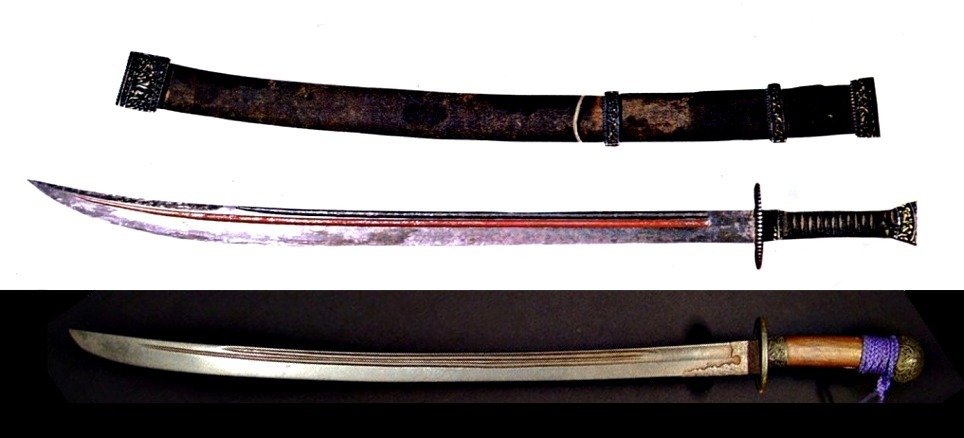 |

Above pic: thought to be from the Ming Dynasty, this saber exhibits the "rolling pearls" design. The "rolling pearls" design was transmitted to China from Indian and Iranian sources. Notice the inlaid silver threaded pattern. Click on the pic to view also, paintings of cavalry and infantry troops of the Ming Imperial Army in the 16th century wielding their sabers.
|
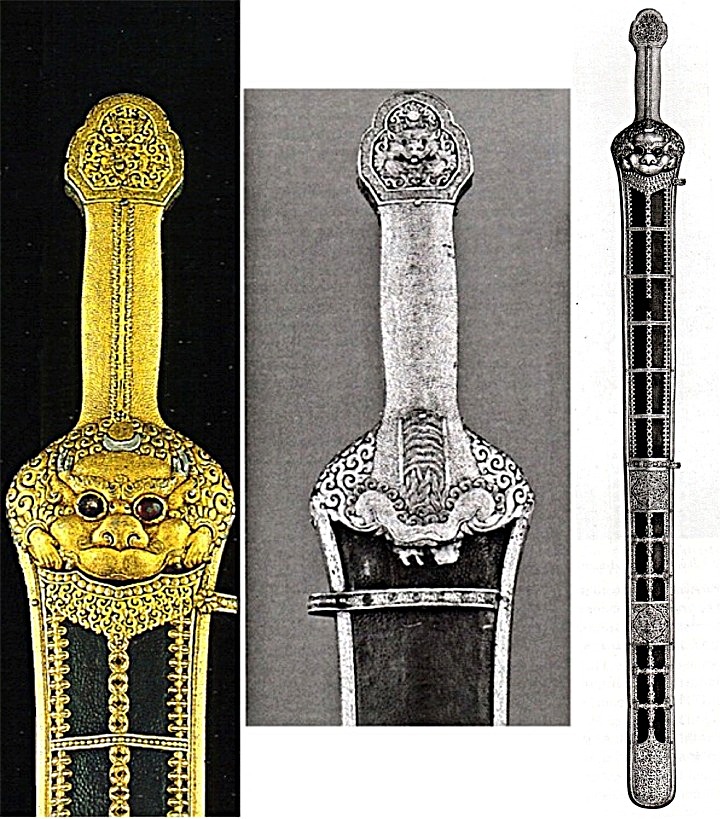
Ming Dynasty Imperial Presentation Jian dating from Emperor Yongle's reign (1403-1424), equipped with a lion face design, and in the collection of the Royal Armouries, United Kingdom. This sword, made as a diplomatic gift to a Tibetan Buddhist temple, has fittings adorned with a combination of Chinese and Tibetan-style design motifs. Click on the above pic to view another Imperial Jian, this time from the Qing Dynasty. For other jians with similar designs as the above, go to: http://chineseswords2.freewebspace.com/custom.html |
|
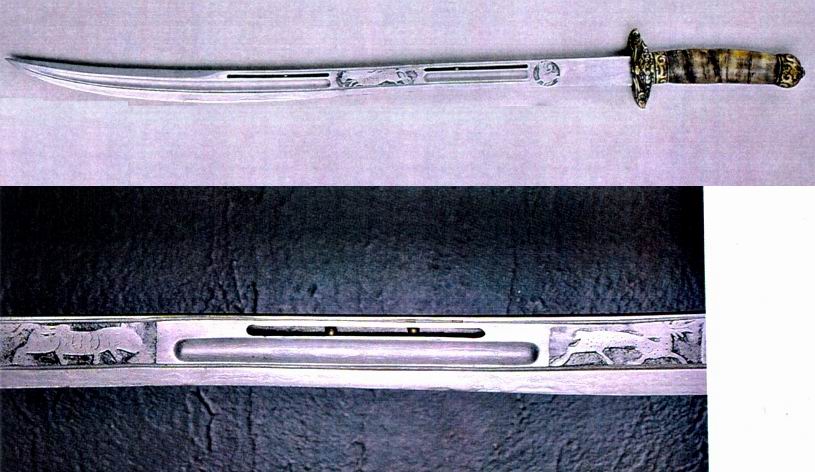
Most likely of 17th-19th century manufacture, this saber exhibits a chamber where "rolling pearls" or "tears of the afflicted" would transverse.
Check out the chiselled cartouches of animals on both sides of the chamber, an influence also from India and Iran.
|
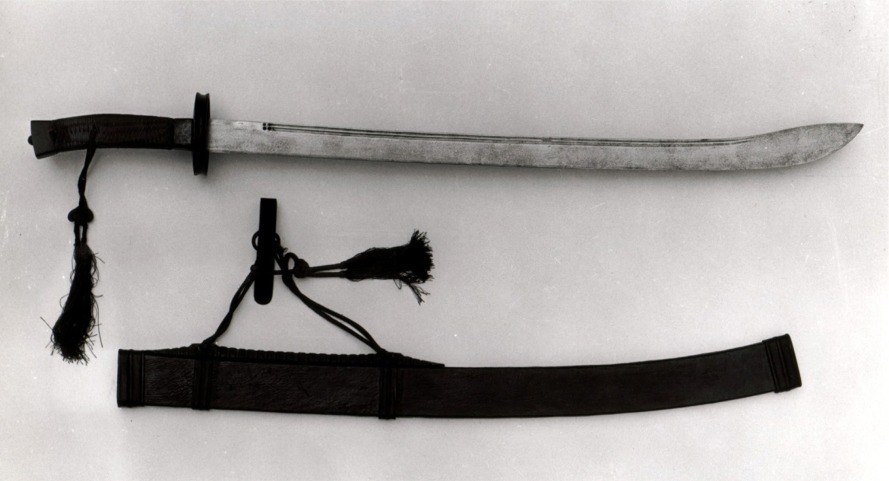
Outstanding pattern-welded twistcore saber from the late Qing with plain cast iron fittings. This beautiful blade, a variant of the yanmaodao (goosequill saber), is presently in the collection of the Metropolitan Museum of Art in New York. The pattern-welded twistcore technique was probably transmitted to China from Indonesia and/or Southern Philippines. |
|

A Qing Dynasty Dao with segmented fullers and a " U " shaped fuller at the forte;
these unique fuller designs derive from Indian and Iranian influences. Scroll horizontally to the RIGHT >>> to see more weapons >>> |
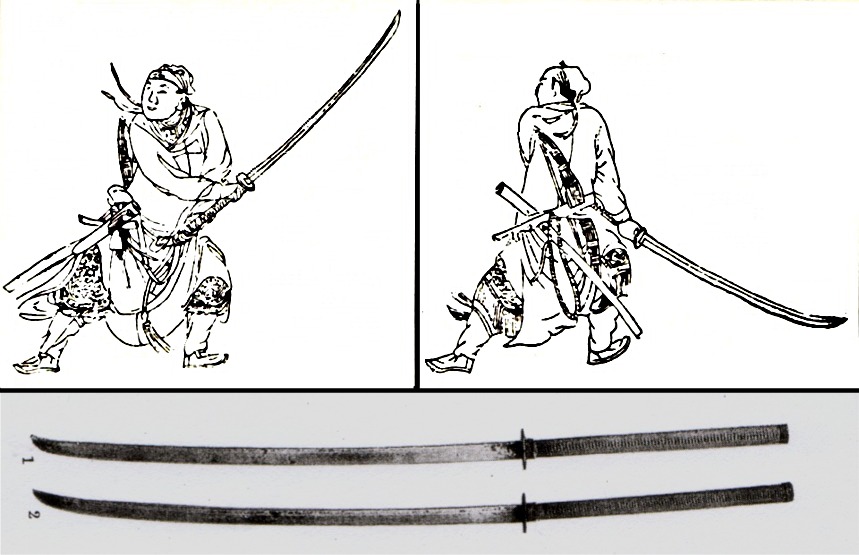
Ming Dynasty two-handed swords (probably early to mid-17th century) known then as the "changdao" but are more popularly known today as the "Miao Dao". These blades have ridged cross-sections and were obviously inspired by the large Japanese swords (known as "nodachi") used by the Japanese pirates raiding the Chinese south-eastern coast. As for the diagrams showing the swordsmen, they are from a Ming martial arts manual published in 1621. These large 2-handed sabers were first used by the Northern Border Troops under the command of Ming General Qi Jiguang in the late 1560s-70s to deal with Mongol cavalry, and remained in use right up to the late Ming (1620s-1644). At that time, these sabers had an overall specified length of 1.95 meters. General Qi, who lived from 1528-1587, had written the influential training manual "Lian Bing Shi Ji" while he was the commanding and training officer for several northern units bordering Mongolia. Commanding about 100,000 men, some of the best troops of the Ming empire, he had successfully deterred Mongol aggression at the border for over 10 years. The structural components he had setup to deal with the formidable Mongol cavalry armies were to consist of 4 parts:
1) Combat Wagon Force
2) Infantry Force
3) Cavalry Force
4) Baggage Supply Train
A brief description of General Qi's Commando Team:
The Combat Wagon Force and Baggage Supply Train are equipped with large and medium caliber cannons. The "Commando Team" is the non-artillery combat component of the Combat Wagon Force and uses a wagon as a large mobile armoured platform. It consists of 8 men -- 4 musketeers (soldiers armed with Chinese-made Portuguese-style matchlocks) individually equipped with the Miao Daos, 2 musketeers both equipped with shield and single-handed saber, and 2 more soldiers both equipped with trident polearms and fire-arrows (arrows driven by gunpowder-propelled rockets).
Upon contacting the enemy, the wagons are to be setup in a rectangular formation and all personnel are to withdraw within this defensive perimeter. After the cannons, muskets and fire-arrows are fired first at long range against the Mongols, the Commando Team would park their long range weapons inside the wagon, then move out of the defensive perimeter and deploy in formation, using their Miao Daos, sabers and shields, plus the trident polearms for close-quarters combat.
As mentioned earlier, the Combat Wagon Force and Baggage Supply Train are equipped with large and medium caliber cannons. General Qi stipulates that for non-artillery soldiers, almost all soldiers specifically equipped with the musket were to be issued with the Miao Dao as a standard issue close-quarters weapon.
The percentage of non-artillery soldiers in the Combat Wagon Force and Baggage Supply Train equipped with this musket/Miao Dao combo (ie those who are not manning the cannons) is 50%.
Another 50% of the Infantry Force are also equipped with the combo. As for the Cavalry Force, the muskets/Miao Dao takes up 20%.
One simple and specific training technique for General Qi's soldiers wielding the Miao Dao is to setup two thick wooden poles, one short and one long, spaced 2 feet apart.
The soldier will then use the Miao Dao like a zhanmadao, bending low while advancing and striking first at the bottom part of the shorter pole to simulate cutting through the horse's legs, afterwhich he will raise and turn slightly to strike the upper part of the longer pole, simulating the strike on the horse's head -- A practical scenario for when the horse dies, the enemy soldier/rider loses his mobility and becomes meat on the platter for the Chinese soldiers.
General Qi had also stipulated compulsory 2-person combat drills using wooden sticks for mock practice, for use in his army.
In my opinion, later on, the Ming "changdao" appears to have evolved into the "wodao" during the Qing Dynasty, as a 2-handed saber used by the Green Standard Army. See my webpage on "Illustrations of Qing Regulation Swords".
Click on the above pic to view other examples of Chinese sabers with ridged cross-sections.
|
|
|
|